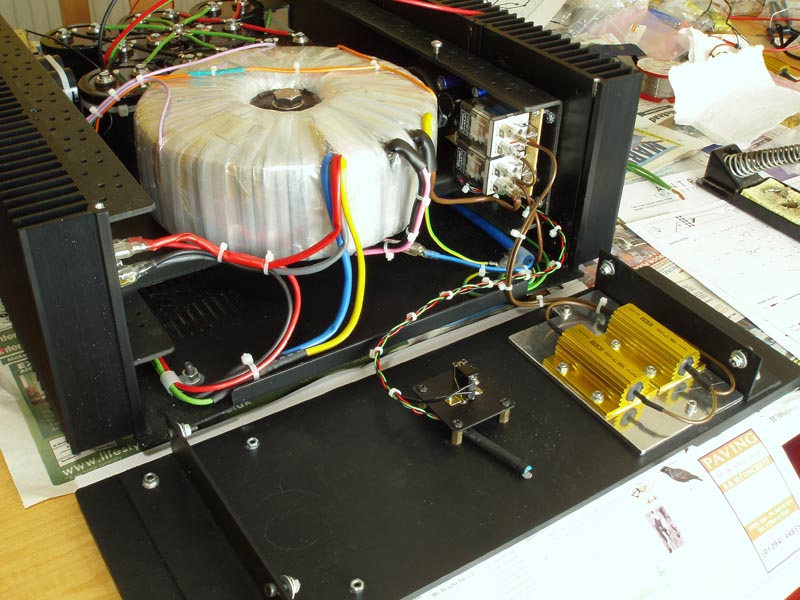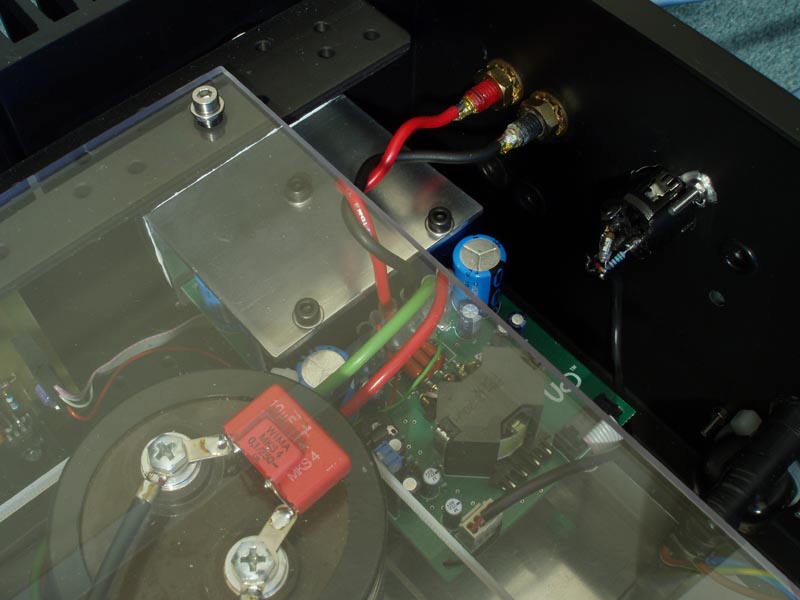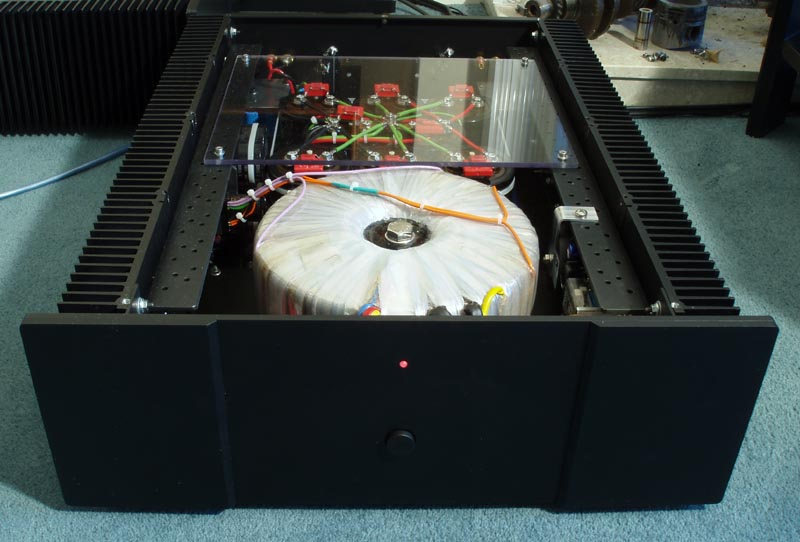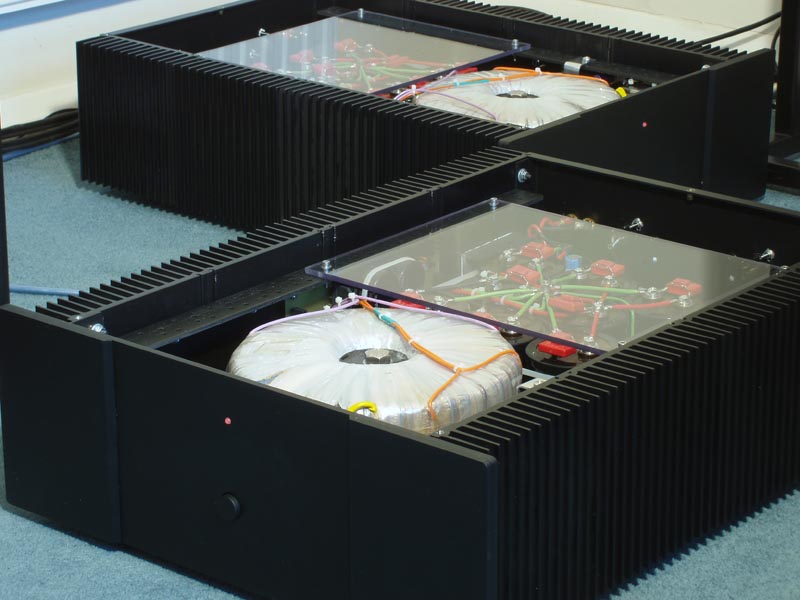Building a Hypex UcD700-based power amp
The second amp was finished a few weeks after the first and in testing seemed to work just fine. There were
some teething problems: On powering up both amps for the very first time, it would be a gross understatement
to say both amps were somewhat ‘unhappy’… Not hum, but a high pitched whining, like a loud mosquito, but
gradually lowering in frequency followed by some noises that are a bit hard to describe but sounded a bit
worrying. Once started, switching off one of them would not fix the problem. One amp on its own – fine.
Two amps on – not fine.

Basically, the amps were going unstable and oscillating like mad. Left like this for any length of time and either the tweeter voice coils would expire or the amps would self-destruct. Or probably both!

Luckily the fix was relatively simple – clarified by a quick search of diyaudio.com. In the end it was not an earth problem, but simply one of needing to limit the bandwidth of the signal entering the amp. This was achieved via a simple low-pass filter to roll-off the top-end frequency response of any signal entering the amp. ‘Turnover’ frequency of the filter seems to vary depending on who you ask. For example, a chap having a similar problem with his Hypex amp chose a cut-off frequency of about 16 Mhz. I preferred to play it conservatively and chose a cut-off of about 225Khz – still way above any music signals of interest and also the same frequency as the similar filter on my own amp (which is there for a similar reason, though nowhere near as acute as on the Hypexes). The resistor and cap are visible – attached to the back of the XLR socket:

So with that fixed and some more soak testing it was time to drag it into the lounge and hook it up to my pre-amp and the Saras. What did it sound like? To be completely honest first impressions were not promising. In fact it sounded dreadful. Very 'HiFi', lots of detail and something extra going on at the bottom end, but otherwise it was completely uninvolving and soulless. No engagement whatsoever. Zero magic. Oh dear, what was I going to tell its new owner?
I left it on for a few hours and tried again in the evening. Still rubbish. The next day I didn't really listen to it very much and just left it playing CD's on repeat. Come the evening, I had another listen. It was slightly better but still way off the mark. I started to think that I should trawl through all the Hypex threads on diyaudio.com…
There was some 'good' news. By this time I was getting a bit fed up so plugged my own amp back in. It sounded a bit better but nowhere near where it should be. Which lead me to believe that some of the reason must be that I was having an incredibly bad mains weekend.
By late evening I resorted to some desperate measures. I needed to 'level the playing field' between the two amps. My amp, still being screwed to pieces of MDF, doesn't have the deleterious effects of a mains fuse or switch in the mains supply. And it connects to an unswitched wall socket via a decent mains lead. The Hypexes were connected via a couple of bits of old mains flex, one 13A the other 6A to a switched wall socket.
I 'degraded' the mains supply on my amp by adding in series one of the original Hypex soft start modules (the still working one) and a fuse holder. For the Hypexes I made up a mains harness out of ordinary 13A flex, but that would allow both of the amps to connect to the mains via the decent mains lead. By the time I finished it was 1am so a bit late for a proper test. However, a quick listen to my own amp (at low volume) suggested the bad mains weekend explanation was probably not far off the mark. The system now sounded as it should – lovely.
The next evening, my amp was now sounding rather less lovely than it had at 1am but much better than 24 hours earlier. The Hypex had made a big step forward and was now sounding not too dissimilar to mine – different rather than better or worse – surely the mains lead? However, although much better, both were still nowhere near the mark. There was also this all pervading 'harshness' regardless of which amp was in use. Not only was it uninvolving, but now it was unpleasant, too. I tried one more thing: Clean, with DeOxit, every single contact on every piece of kit from mains plug pins to loudspeaker connectors. And take out the fuses, polish them with Brasso and clean again with DeOxit.
This took about 30 mins and it was now about 9pm so I don't really know if the following was due to the DeOxit cleaning or the mains getting better (probably both). Anyway, the Hypex was plugged in and KT Tunstall's debut album was first up (side B). An hour earlier, it sounded distinctly average, however this time around it was obvious from the first note that we were at last making progress. The way it swelled from nothing, washed over me and then died away sounded as natural and focussed as I remember it should on my amp (on a good mains day!). Suddenly things sounded 'correct', natural and in perspective. Relationships between backing and lead instruments were making sense again. Yes, welcome back to music – hooray!

Basically I replayed all the same records from earlier in the evening and without exception they all sounded miles better. I mean hundreds of miles better. We'd returned to 'first base', i.e. when a system is good enough to make you stop reading whatever it is you're reading as you can't ignore what's happening on the other side of the room. And, things just got better and better over the next few hours and record after record. I know when a HiFi is working well because it's not just what it sounds like, it's what it does to you, well what it does to me, anyway. Everything sounds wonderful and it makes you feel wonderfully calm and relaxed, yet excited at the same time. And you get taken to that 'special place' where everything is lovely. All good stuff!
For whatever reason, the Hypex amps were now definitely doing the business. I didn't feel the need at any time to plug my own amp back in, although there were differences. The Hypex seemed to hold singers a bit further back in the mix, almost as though a bit of a 'hole' had been left in the middle where they should be. As I'm a big fan of female vocal, I wasn't too sure about this at the time.
On the other hand, The Hypexes extract more detail from the mix and are better at showing you the different layers within the mix of a song, although perplexingly they don't do this by 'spotlighting' stuff in the background like my amp does, but somehow they still manage to do this. On the other hand I wouldn't say they're completely transparent and open – there almost seems to be a layer of 'fuzz' just beneath the surface, though I'm not sure if this is due to something else in the system? Tonally, I think my amps are just a smidgen richer but I'd have to do a back to back comparison to be sure. The Hypexes counter with greater inner detail – a strummed guitar has great insight into the way it's being played and what's going on 'within the strum' as it were.
They also just about hold that detail together into a meaningful whole so they don't do 'analysis paralysis'. However, I get the feeling that some of the shortcomings here may be due to the turntable reaching its limit and not the amps. I definitely felt that the Hypexes had more to give and were still running in.
The Hypexes also have greater urge at the bottom end. They're more extended but also nicely controlled and articulate. And they have more wallop, which is nice. Not sure yet how I get my own amp to do that.
Perusing some of the forums, it seems Hypexes need time to run-in and can sound not-great when new. This seemed to be born out as over the course of the following week they slowly but surely got better and better. At no time did I feel the need to plug my own amp back in.

A week after the second amp was finished my friend, for who the amps have been built came around for a listen. He brought his Nap250 with him to provide another reference point. The rest of my system consisted of Circused and Lingoed LP12, Ittok, Karma. The Lingo having had the ALW-filter-mod. This TT sits on top of two composite and one glass shelves on an Audiotech stand. Pre-amp is a work-in-progress 'Air-guistariste' with diy 323 phono section. PSU is via VBE'ed ALWSRs fed from individual Elna Cerafines and two of LesW's 350VA AST toroidals. My own power amp is a, work-in-progress, Mosfet design. It's about 26 years old and I'm currently in the process of overhauling it. The Nap250 is of the early bolt-together vintage. It was serviced by Naim in 1996 but thereafter remained almost unused for the next eight years. Speakers were Linn Saras.
We started with the 250 and played a number of tracks. My friend, still acclimatising to my system, thought overall it sounded ok. Initially I thought it was ok, too. However it was also very quickly evident that something wasn't quite right, or rather something was missing – all the detail! Overall it sounded over polite, soft and inoffensive. This much was a little bit of a shock but possibly to be expected given the vintage of the 250. However, what was a really big shock was that there was no involvement or engagement whatsoever, which is traditionally a Naim strength. I remember I was just waiting for each track to finish because everything we played sounded, to me, rather boring like it was being played by rubbish tribute bands! Basically, in this system, I thought it was a bit hopeless but at the same time felt a bit sorry for it – a bit like a nervous newbie giving his maiden presentation at a speakers club. I do wonder if the amps current limiters were overly influencing matters – I recall having the volume knob set much much higher than ever, but it wasn't that loud. Strange.
Next up were the Hypexes. I'd accidentally left the volume at the same setting we were using with the 250. And even though, the Hypexes have less gain than the Naim (I believe), the first track just blew us out of the room – quite literally, it was so loud! The differences were stark, the tribute bands had been replaced by the real ones. And they sounded like they'd all rocked up in front of the fireplace of my lounge. It's a bit difficult to describe where the Hypexes were better because everything was better and by a huge margin. All the HiFi bits were great – considerably more detail and therefore insight into how tracks go together and how instruments were being played. Musically, they seemed right on the money, too, very engaging to listen to, aided by all that detail. What helped even more is that these amps have an almost irresistible drive or urge to them. Not an in-your- face kind of urge but something that makes them very compelling to listen to, and to want to keep listening to. And what in turn aided this was that the bottom end went lower, was more articulate and was delivered with great punch. Bass lines really did provide a solid foundation upon which the rest of the band could work from.
Just returning to how loud they could go, they seem so clean and clear at high volumes that it wasn't apparent just how loud we were playing stuff until we realised that we couldn't hear ourselves or each other even when shouting. I'm convinced that the Saras had never in their lives had such a work-out and they seemed utterly at the mercy of the amps. I'm usually a bit worried about disturbing the neighbours when I play stuff loudly, but here we were playing louder than I'd ever done before but because it didn't sound loud, I wasn't worried about the neighbours!
Downsides? I don't think these amps are ever going to be a velvety, valvey, class-A kind of sound. In other words they're a bit forward in the mid and there was something else going on which makes them not completely transparent. HiFi journos talk about 'the spaces between notes not being completely black' I've no idea what this means but somehow it seems appropriate here! To put this into context, these defects are relative to the excellence it exhibits in all the other areas rather than in comparison to the Nap250 or my own amps. I do wonder if there would be gains to be had by changing the op-amp (currently an AD8620).
We did do a quick comparison with my amp towards the end of the evening. I thought it held up pretty well – it wasn't quite as detailed, it didn't have that amazing 'drive', it didn't go as low nor did it have the same punch. But I felt it was similarly musical, which is the first thing you want any piece of HiFi to do. It was as if things had been turned down from '11' to maybe '8'. Although we agreed on the relative ranking of the three amps, my friend was inclined to place it much closer to the 250 whereas I felt it wasn't that far behind the Hypex. If it was boxing match, the 250 would have been KO'd 10 seconds into the first round whereas I like to think my amp pretty much stayed the distance but lost on points – imho of course!
With the passing of another couple of weeks, the amps were still getting better. I felt that their weaknesses were becoming less so. They no longer seem too forward, but conversely, singers seemed to have stepped forward a couple of feet to fill the 'hole' that was there when they were new. I don't feel so compelled to muck around with changing the op-amp, either, so that must be a good sign. I have tried my own amps from time-to-time but usually feel that something is missing and switch back to the Hypexes. Well, if you had the choice between two amps that were not musically dissimilar but one had the better 'HiFi' attributes, which would you choose!
I somehow reckon it should be ok to drive the Scintillas, too.
Now read on for what my friend thought…